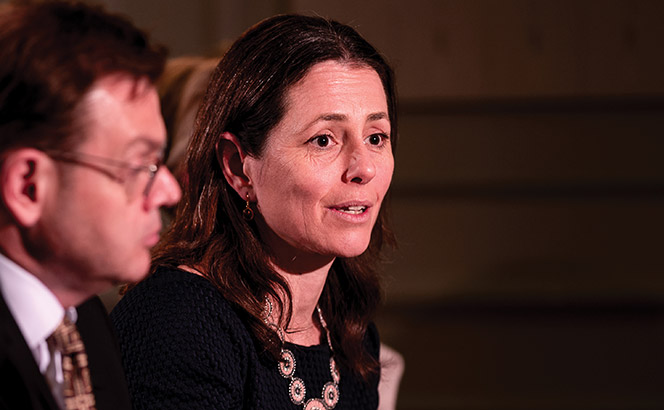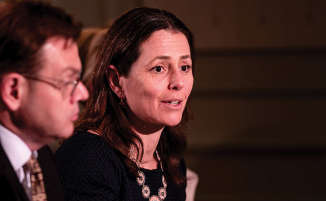Legal 500 editors Georgina Stanley and Ben Wheway take an in-depth look at gender diversity in the latest Legal 500 London rankings
‘Institutional male dominance is hard to shift – it isn’t enough to want to change; sometimes these things are structural,’ says Travers Smith disputes partner Caroline Edwards (pictured) of the difficulties women lawyers can face trying to build their profile in the legal market and the directories that reflect it, including The Legal 500.
‘But it matters,’ she adds, ‘partly because it’s the external perception of you and your place in the market, and partly because it’s important for clients – particularly international ones’.
‘It’s really important to be in the directories’, adds Irwin Mitchell London managing partner Alison Eddy. ‘Role-modelling is really important. People in senior roles are key influencers for junior lawyers.’
We may be slightly biased, but at The Legal 500 we are well aware of the importance that an individual ranking holds when it comes to boosting the personal profile of a lawyer. And we are also under no illusions as to the frustrations for lawyers repeatedly overlooked while peers they view as less deserving are routinely recognised. And this frustration is justifiably more significant if there are concerns that the omission is due to differences in gender, race, or any other aspect of diversity.
For this reason, we are absolutely clear that, when it comes to improving diversity in the legal profession, The Legal 500 has an important role to play in increasing inclusion and being part of the discussion around it.
Yes, law firms still need to do much more to fix unequal representation within their ranks, particularly at senior levels, but if that diverse talent is there, legal directories have a duty to identify and promote the individuals embodying it.
‘Genuine inclusiveness comes from the top down – there’s no point saying words if they’re not lived. It needs to be a very significant part of senior management’s agenda.’
Caroline Edwards, Travers Smith
Ensuring that we play a meaningful part in this process means tracking our own progress and holding ourselves accountable. If we don’t scrutinise the numbers and accurately assess the current state of play, then continued improvement risks not being sustained.
Here, then, we take a detailed – and honest – look at how we’ve done over the two years since I joined The Legal 500, when I stated that improving diversity was a key priority.
Headline numbers
The size of The Legal 500 UK guide means that retrospectively measuring all aspects of diversity across the nearly 10,000 individuals ranked across the country is a huge task.
As a starting point for this year, we have looked only at the London 2021 rankings, which were published in September, and have looked only at gender.
This is not because we think London is more important than the rest of the UK, or that gender diversity is more important than any other aspect of diversity – I would like us to be able to extend such analysis to the rest of the UK and, if possible, BAME representation over the coming years.
But for a starting sample, the data we have on women already ranked in London makes it possible to monitor differences between practices and firms, as well as progress that has already been made.
In total, across 126 London practice areas we currently rank almost 5,000 individuals as either Hall of Fame, Leading Individual, Next Generation Partner or Rising Star, and just over a third (34%) of these are women. Taking the 30% Club as a benchmark, this is a metric that broadly stands up to scrutiny.
Drilling down into the seniority of those ranked, just under 30% of our Leading Individuals are women, with this figure dipping to 20% for Hall of Fame, reflecting the fact that entry to the Hall of Fame is currently determined by number of years served as a Leading Individual, meaning that our representation is inevitably weakest in this area.
While 30% is an acceptable figure for an industry like law, where the upper echelons of the profession remain dominated by white men, particularly in the City, it is important to note that the pipeline of talent is reassuring. Women make up just under half (47%) of our Next Generation Partners, with this figure climbing further to 55% for Rising Star associates.
Assuming that most of these talented female lawyers remain in private practice and continue to receive appropriate career development from their firms, then our rankings should continue to shift towards a better gender balance at all levels.
It is vital that we achieve this, so that we can demonstrate that we are accurately reflecting a profession where women make up more than half of those joining at the junior end, and that we are helping those individuals build a profile that will aid their career progression – as well as providing clients access to information on the diverse selection of lawyers that they are increasingly seeking.
By practice
While almost two thirds of our 126 London practice areas are now at least 30% female across all ranks, averages do of course mask wide disparities between different practices and different firms.
The practices that have the highest percentage of women ranked at all levels are, perhaps inevitably, some of the less transactional areas.
Our new international business reorganisations section, which ranks firms for their work on complex event-driven reorganisation projects, tops the rankings by gender diversity – with women making up 75% of all those ranked. This is closely followed by retail funds and clinical negligence, with family, employment and immigration all also within the top ten.
But we are also improving diversity in the rankings for other traditionally male-dominated areas. The total number of women ranked in acquisition finance and private equity – both areas where only one woman was ranked two years ago – has risen to 22% and 26% respectively.
Commercial litigation, meanwhile, is the practice that this year has seen the biggest increase in the number of women ranked. In part, this reflects the creation of our new ranking for mid-market commercial litigation but the overall percentage of women ranked across both sections is now 32% – up around 10% on last year.
Edwards, who was the first-ever woman to be promoted to partnership in the disputes team at Travers when she was made up ten years ago, comments: ‘Within Travers, we’ve achieved a 50:50 split in the team’s partnership within ten years, and that’s amazing. Genuine inclusiveness comes from the top down – there’s no point saying words if they’re not lived. It needs to be a very significant part of senior management’s agenda.’
Our M&A rankings have also significantly improved since two years ago, when just four women were ranked; now the rankings are 30% female.
By firm
As part of our analysis, we have also looked at female representation by firm. This measure shows significant differences between individual performance, in some instances reflecting a more ‘female friendly’ practice focus at specific firms and in others, perhaps, a firmer approach to building female talent both internally and their external perception in the market.
For firms with a minimum of 20 people ranked in London, Bindmans has the highest overall percentage of ranked women – three-quarters of all of its ranked individuals are female. The firm leads a table dominated by key players in the public law, crime, property and clinical negligence rankings, with Bates Wells, Kingsley Napley, Boodle Hatfield and Leigh Day rounding out the top five.
Bindmans crime fraud and regulatory head Katie Wheatley comments: ‘We’ve had family-friendly policies for decades and it’s borne fruit now – people work extremely hard, but we don’t have a presenteeism culture.’
With 56% of its ranked London lawyers female, Irwin Mitchell is the highest-ranking Legal Business 100 top 25 firm by this metric, an achievement Eddy attributes to the firm’s family-friendly policies, its practice mix (in fact, the firm is now actively trying to recruit men in some practices to improve the gender balance) and the large number of female role models in a firm where around half of partners are female and many offices are run by women.
Looking at the individual rankings by total number of women ranked in London, Clifford Chance and Herbert Smith Freehills lead the pack with 48 and 46 female lawyers ranked across all areas respectively (see stats below for more breakdowns)
The future
As the numbers above highlight, although we have made some significant progress, we are still a long way from finished.
It is crucial that we continue to monitor female representation on an annual basis; to ensure that in those practices where we have made progress, that progress is consolidated and that women continue to move through the rankings. It goes without saying that inclusion in our rankings will only be achieved by merit, but change means we will be continuing to emphasise diversity as part of our research process.
We need firms to put forward more talented women across all practice areas – if your partnership is 30% female then arguably 30% of those you are putting forward for consideration for an individual ranking should be female.
Being put forward for consideration is not enough though – to achieve a ranking firms need to ensure that these talented lawyers have had the same opportunities to work on high-profile mandates and build their market profile as male lawyers.
This is likely to be a particular issue in the post-pandemic world. Anecdotally, stories abound of women in all professions being furloughed in larger numbers, or being forced to scale back their hours to revert to family responsibilities.
Firms must ensure that this does not send gender diversity efforts backwards. There is an opportunity for firms to seize the acceptance of flexible working and translate it into a more inclusive environment for all – but the risk is that working from home will see a return to life along traditional gender lines many had been moving away from.
The Legal 500 rankings can only reflect the current reality within law firms, so we need your help to change. It is vital that we correct this longstanding imbalance – not just because it is fair and the right thing to do but also because it is a business imperative. Clients want their law firms to be inclusive and they will want to see this reflected in our rankings.
While we will not be ranking firms for diversity, we will be looking at ways we can better reflect diversity within firms and whether changes to the criteria for our rankings, such as Hall of Fame may help to recognise long-overlooked female and minority partners.
BAME representation – both within firms and our rankings – remains the elephant in the room but it is not something we can shy away from. It is clear that our rankings are not inclusive at present in this regard, particularly when it comes to black lawyers. Yes, in large part, this is down to the lack of diversity within firms’ own teams at a senior level but there is more that we can and should be doing to improve our rankings here.
Please do get in touch with any thoughts you may have as to how we can improve, as well as with suggestions for deserving candidates – it is incredibly important to all of us at The Legal 500 that we are fully inclusive of all talented lawyers, regardless of race, religion or gender.
London practice areas with highest percentage of ranked women
Firms with highest percentage of ranked women in London*
*Firms with at least 20 lawyers ranked in London.
Firms with most ranked women in London
Firms with most ranked women in London – by ranking type
Where women are ranked – by Legal 500 sections
1,630 women are ranked in London – this chart show how that breaks down by section.














